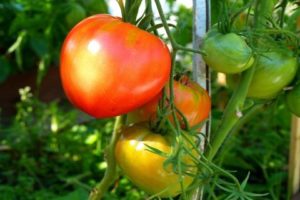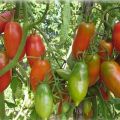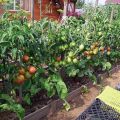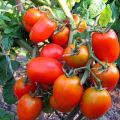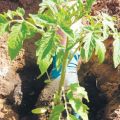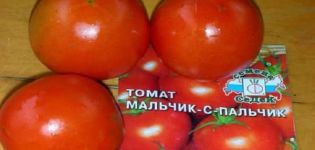Characteristics and description of the tomato variety One hundred pounds, its yield
Tomato One Hundred Pounds is classified as a mid-early variety. In 2013, the variety was included in the State Register of Breeding Achievements of Russia. The variety is very useful, since the fruits contain a large amount of sugars, the antioxidant lycopene, fiber, beta-carotene, which is converted in the human body into vitamin A. 100 g of tomatoes contain 20 kcal, because of this tomatoes can be consumed by those who want lose weight.
there is grade Sugar pudovichokbut this is a completely different variety. Unlike the Hundred Pounds tomatoes, Sugar Pudovic's tomatoes have an even, rounded, slightly flattened shape.
Characteristics of the variety
Characteristics and description of the tomato variety One Hundred Pounds: it takes about 110 days from germination to picking tomatoes, the bushes are indeterminate, up to 2 m in height.In open ground, the bushes are smaller: up to 1.5 m in height.
Description of the variety: medium leafiness of the bushes. The leaves are small, dark green. One brush contains 3 - 5 fruits. Up to 6 kg of tomatoes are removed from 1 bush, up to 9 kg from 1 m² of plantings. In the south, the variety can be grown outdoors, in the Central region of Russia, seedlings can be grown by planting them in greenhouses.
Description of fruits: large, their weight is 170 - 300 g. Rounded pear-shaped in shape, ribs near the peduncle are clearly visible. Looks like a pouch filled and tied on top. When fully ripe, the tomatoes are scarlet. The pulp is juicy, few seeds. But since the yield is huge, you can collect your seeds for planting. The skin is thin, but dense, does not crack. The taste is excellent, sweetness prevails, the acidity is barely noticeable. The fruit does not have spots around the stalk.
The fruits are well stored and well transported. Tomatoes can be picked unripe.
Tomatoes One hundred pounds are eaten fresh, put in dishes, canned, squeezed out.
Benefits and cons
The main advantages of the variety:
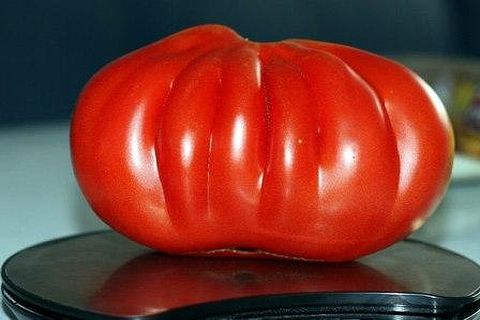
- excellent dessert taste, very healthy;
- high yield;
- tomatoes are stored for a long time, have an excellent presentation;
- transportable;
- unpretentious in care;
- well tolerates sudden changes in temperature, drought;
- has immunity to major diseases.
The minor disadvantages include the fact that the bush needs to be formed, not only the stems, but also the branches to be tied up.
Sowing seeds
Seeds are sown for seedlings in the third decade of March. Before sowing, put the seeds in a bag of gauze and immerse them in a pink solution of potassium permanganate for a quarter of an hour. Next, put 2 drops of Zircon in 100 ml of water and lower the seeds for 6 hours.
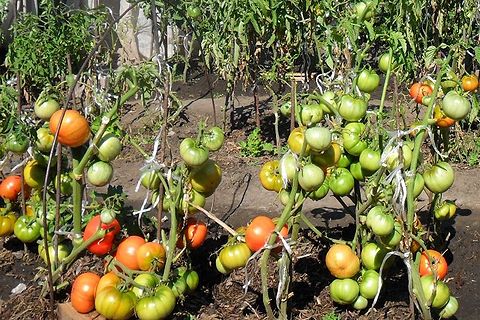
Make soil by mixing garden soil with humus, peat, add a little superphosphate, ash. Calcine the soil for 20 minutes in the oven at a temperature of 200 degrees.
When planting, deepen the seeds by 1 cm, water the plantings from a spray bottle, cover with foil, put in a warm room.
When shoots appear, remove the film, put the shoots on the windowsill. Water with a spray bottle or watering can. When 2 true leaves grow, dive seedlings. Then fertilize with a solution of complex mineral fertilizer.
When to plant seedlings in the greenhouse? When the seedlings are 2 months old, transplant them into a greenhouse. Seedlings are planted in the place where cucumbers, legumes, cabbage, onions, carrots grew before.
When planting seedlings, first drive in the pegs, then mix 3 - 4 bushes per 1 m². Water the seedlings. Tie the bushes to a trellis immediately.
Care
Water the tomato bushes 100 pounds in the evening with warm, well-settled water, as the tomatoes grow more slowly from cold water. Pour 1 liter of water under each bush. Water the tomatoes once a week, loosen the ground after watering. Pick off weeds and dry leaves.
Feed 3 - 4 times per season. Apply nitrogen before blooming. Can you feed the tomatoes, adding st. a spoonful of ash in 1 liter of rainwater. Pour half a liter of ash water under one plant, being careful not to get on the foliage.
With the formation of buds, you can fertilize the bushes with humus, having previously watered them abundantly with water. Pour 1 bucket of humus on 1 m² of land, pouring it in a layer of 2 cm, and immediately after humus, feed the bushes with a solution, pouring 10 g of Baikal into a ten-liter bucket of settled water, then pour the solution over the humus.
Instead of humus, you can make such a top dressing: pour 1 - 2 kg of bird droppings into a ten-liter bucket of rainwater. Leave it on for a week. Then dilute the fertilizer with more water at a ratio of 1:20. Pour liquid top dressing under the root until flowering, half a liter per bush. This is a fairly intense nitrogen fertilizer.
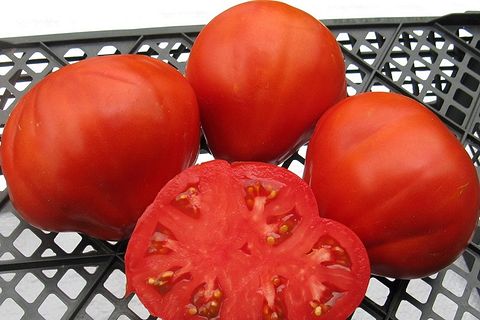
After fruit setting, feed the bushes with magnesium sulfate or superphosphate.
Leave 1 - 2 stems, pluck the rest. Be sure to remove stepsons. Tear off 2 to 3 bottom sheets every 10 days. To make the tomatoes large, pluck the flowers, leaving 3 - 4 on each brush.
After planting, do not forget to immediately tie up the bushes, and as the fruit forms, tie up the branches.
Diseases and pests
The cultivated variety is resistant to disease, but preventive measures must be taken. Spill the ground with a solution of copper sulfate before planting seedlings. Completely change the topsoil in the greenhouse every year. Ventilate the greenhouse every day. Spray plantings with phytosporin to prevent fungal diseases.
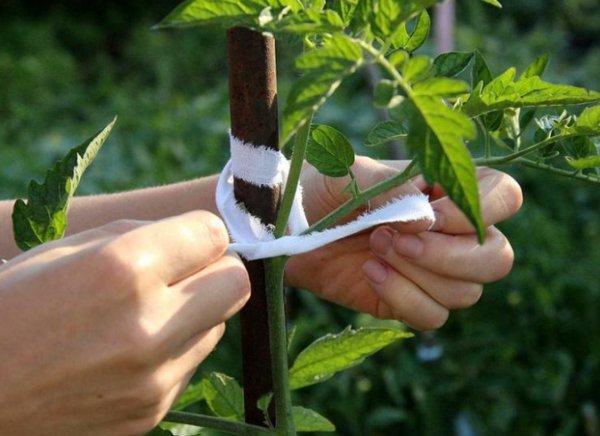
If the bushes are attacked by parasites, use insecticides or wash the bushes with warm water and soap, ammonia, celandine infusion.
Pour 200 g of dried celandine in 5 liters of hot water, leave for 2 days, then spray the bushes. You can spray the bushes with the biological product Bitoxibacillin, adding 35 ml to 5 liters of water.
Conclusion
Reviews of the variety are enthusiastic. Those who planted this tomato often note the wonderful dessert taste of tomatoes. Reviews about the variety from the Gavrilov family living in Chelyabinsk:
“We planted seedlings in a greenhouse. The bushes have grown to almost 2 m. Yielding variety, ribbed tomatoes, bright red, delicious, fleshy. We will plant more, because we liked the shape of the fruits, their yield and sweet dessert taste. "
Reviews of the Mironov family living in the Moscow region, the city of Dmitrov:
“We planted the seeds of the Aelita firm. The variety is immune to disease, unpretentious. Gathered a great harvest. Description of tomatoes: weighed 200 - 300 g both from the first tassels and from the crown. They made lecho, pasta from tomatoes, squeezed juice. "
The variety fell in love with gardeners for high yields, healthy, tasty and beautiful large fruits.

